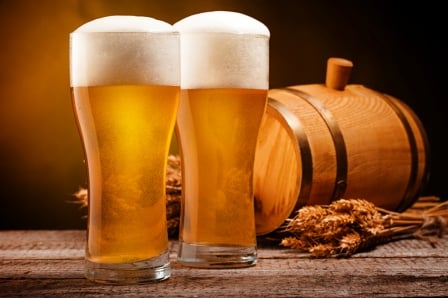
This week I take an in-depth look at my Witbier recipe and some of the design decisions made in designing this beer. This is a recipe I’ve brewed dozens of times over more than two decades, but it always delivers a refreshing taste and finish.
The Witbier Style
Witbier is a Belgian style of beer, with a slightly spicy finish and distinctive yeast character. It is a very drinkable, refreshing, moderate strength and often has some haze from the use of unmalted wheat. They are often highly carbonated, have a dry finish and are lightly spiced.
The BJCP style guide lists Witbier as having a color between 2-4 SRM, an original gravity of 1.044-1.052, bitterness between 8-20 IBUs and an Alcohol level of 4.5-5.5% ABV. Characteristic ingredients include a large portion of unmalted wheat, sometimes raw oats, a distinctive wit yeast and also spices including Curacao orange peel and coriander seed.
Designing a Witbier
When sitting down to design a beer, I like to start with the grain bill as it is usually one of the easier pieces to settle. In the case of Witbier, the BJCP style guide recommends 40-60% unmalted wheat, so I decided to start with a 50-50% split of pale malt and unmalted wheat as the base. I did not include oats, though some brewers do as I feel the unmalted wheat provides enough protein and body on its own.
The only question was which type of unmalted wheat to use. I immediately discarded raw wheat as that would require an extensive cereal mash to convert it and I wanted to keep things simple. That left flaked and torrified wheat as options. Flaked wheat is more widely available so the final malt bill is simply 50% pale malt and 50% flaked wheat. Use Belgian pale malt if it is available. I targeted an original gravity of 1.049 which gives an ABV of approximately 5%.
Bitterness is not a major feature of the beer but you do need enough hops to balance the malts. I decided to use East Kent Goldings as it is one of my favorite classic English hops instead of European hops. While I could perhaps have used one of the popular Continental hops like Hallertauer or Tettnang, I felt that the English hops might give it a more mild but slightly complex finish without the spice of some of the noble hops. My goal was not to highlight the hops, but simply balance the beer. I hopped to a 19 IBU level which is within range for the style. For the same reason, there is no need for a whirlpool or dry hop addition.
In keeping with a simple to brew drinkable beer, I opted for a basic medium body, single infusion mash with no mash out. The beer already has plenty of body from the flaked wheat, and requires no special mash steps. While the mash can run a bit thick due to the large amount of flaked barley, I’ve not had problems with a stuck mash on this particular beer.
Traditional wits are made with a small addition of spices, so I used the classic Coriander Seed and Curacao Orange Peel combination added 5 minutes from the end of the boil to give it a bit of spice finish. For this particular style the use of Witbier yeast is actually important as it provides the phenolic finish that is characteristic for this style. As a result I picked White Labs WLP400, Belgian Wit Ale as the yeast to use.
Brewing BeerSmith’s Wit
The brewing of this beer, much like the recipe itself is an exercise in simplicity. Mash the 50-50% pale/wheat malts using a medium mash temperature, sparge and boil as you normally would using the single boil addition of hops and then add the spices 5 minutes from the end of the boil. Cool and pitch the yeast and ferment at room temperature for two weeks. Then bottle or keg as desired, carbonating at just a bit higher level than you might normally.
The result will be a nice pale ale that may have a slight haze from the wheat, but is very light, refreshing and drinkable. Even my friends who were raised on mass market American Adjunct Lagers like Budweiser and Michelob all enjoy drinking my Wit and its a great summertime beer.
Here’s the full recipe for the Wit on the BeerSmithRecipe site which you can easily download or make a private copy of so you can scale it to your equipment profile in BeerSmith:
- BeerSmith’s Wit – Original 5 gallon (19 l) recipe
- BeerSmith’s Wit – Scaled up for 11 gal (40 l) BrewEasy
I hope you enjoyed this week’s article on designing a Witbier. Thanks for joining me on the BeerSmith Home Brewing Blog. If you want to take the guesswork out of brewing, please try my BeerSmith recipe software from BeerSmith.com. Be sure to sign up for my newsletter or my podcast (also on itunes and youtube) for more great tips on homebrewing.
